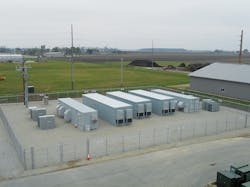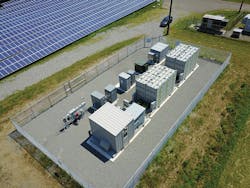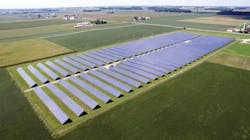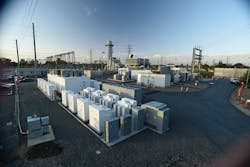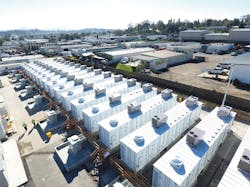Electricity energy storage has been getting a great deal of attention thanks to some high-profile utility projects with manufacturers such as Tesla and its Hornsdale 129-MWh lithium-ion (Li-ion) battery project. This project grabbed the world’s attention when Elon Musk bet the South Australian government he would deliver a fully functional storage system in 100 days or it would be free. His company did it in under 100 days, but more on that later.
Another major event that directed attention on energy storage was the massive gas leak from the Aliso Canyon underground natural gas storage facility outside of Los Angeles, California. It was reported the gas leak would cause shortages that could disrupt electricity generation, with the possibility of rolling blackouts. To meet the problem, utilities deployed 100 MW of storage in roughly six months.
Highly visible projects such as these show how important energy storage systems (ESS) are becoming to the smart grid. They are placing reliable electric power exactly where and when it is needed. Battery-based storage is experiencing a resurgence thanks to advancements in the technology and improvements in its capabilities. These systems can store more energy and deliver more power than previous batteries could. Maintenance also has been reduced as battery life has increased, thanks to developments in power conversion and the adaption of power electronics found in state-of-the-art ESS.
Understanding the Technology
Nowhere is that more apparent than in Li-ion battery storage systems. Electric vehicles (EVs) and other consumer electronics have brought down Li-ion battery costs, improved their reliability and increased their capacities. With advancements such as these, battery-based energy storage systems (BESS) are effective energy solutions for utilities. However, the industry is a conservative group and has performed a great deal of its own research and development, along with many pilot programs.
Southern Company recently launched an energy storage demonstration project with the Electric Power Research Institute (EPRI) and Tesla. The project is focused on a Li-ion BESS that can be sited, installed and operated by industrial and commercial customers to store energy during off-peak periods and use it when demand is high. It will offer peak shaving, demand management, backup power and other services. The results will determine if Southern Company should expand the deployment of ESS for its commercial and industrial customers.
EPRI also has a research project with Louisville Gas & Electric and Kentucky Utilities Co. to evaluate utility-scale BESS technology. They will investigate ways to enhance resiliency, manage costs and optimally incorporate energy storage on the grid. The equipment will be supplied by LG Chem, Dynapower and Greensmith Energy.
In Denmark, the four-year energy project EnergyLab Nordhavn started in 2015. It has been implemented in the Nordhavn district of Copenhagen. The project seeks to develop and demonstrate energy technologies with the objective of making Copenhagen the world’s first carbon-neutral capital by 2025.
In 2017, DONG Energy and ABB completed integrating the first urban Li-ion BESS in the Danish grid, which is part of the EnergyLab Nordhavn project. The goal is to learn firsthand about how BESS technology will interact with the grid. The project partners include The Technical University of Denmark, City of Copenhagen, By og Havn, Radius, HOFOR, Balslev, CleanCharge, Danfoss, ABB, Metro Therm, Glen Dimplex and the PowerLab facilities. Funding for the project is supported by the Danish Energy Agency.
Providing Services
There is no doubt BESS can provide electrical power, but utilities also are seeing value in the innovative services this technology can supply — such as peak shaving, load leveling and capacity firming — which is allowing them to delay infrastructure investments. BESS also is helping utilities with congestion relief as critical nodes become more constrained, which is compounded by the unpredictability of wind as well as solar power and could lead to curtailments without them.
Recently, Half Moon Ventures installed S&C Electric Co.’s 7-MW PureWave SMS on the distribution network owned by the municipal utility in Minister, Ohio. The device provides a fully integrated storage management and power conversion system, which includes 3 MWh of Li-ion batteries supplied by LG Chem. The S&C system is connected to Half Moon Ventures’ 4.2-MW solar park, which is adjacent to the Village of Minster. S&C designed the system to provide frequency regulation for PJM’s Frequency RegD Market and configured the PureWave SMS to interface with PJM market-interfacing software to enable the system to follow signals from PJM.
General Electric (GE) has announced its Brilliant Turbine Platform, an application for wind turbines that integrates energy storage directly into the wind turbine. This is a short-term energy storage application. GE said it will provide three unique software applications to enable turbine operators to choose the services that best suit their needs: ramp control, frequency regulation and predictable power. The last application lets the system smooth out wind generation peaks and valleys. The system can be applied to new turbines or retrofitted to existing GE turbines.
In Europe, DONG Energy announced a BESS project that integrates an ABB BESS device right onto the 90-MW Burbo Bank offshore wind farm, located near Liverpool, England. ABB reported it will provide a 2-MWh BESS to support the integration and transmission of power from the wind farm. ABB said, “This project represents the first integrated BESS on an offshore wind farm for grid frequency stabilization in the U.K.”
Hybrids
The electric power industry often tends to think of energy storage as something new, but it has been an important part of the grid for many years. The Energy Storage Association (ESA) reports Southern California Edison (SCE) celebrated five years of operation for the Santa Catalina Island ESS on Aug. 26, 2017. SCE’s ESS was designed, installed and commissioned by S&C. The 1-MW system uses a sodium-sulfur (NaS) battery with S&C’s PureWave SMS. The PureWave system permits the ESS to store energy efficiently and release power generated by the island’s six diesel generators and 1.4 MW of microturbines. ESA says the S&C PureWave ESS has enabled the diesel generators to be operated in their lowest emissions configuration, meet all California’s environmental requirements and provide SCE with a variety of operational data.
Another innovative approach from SCE is its hybrid peaker plant, which combines natural-gas-fired turbines with BESS technology and sophisticated software. SCE and GE are partnering for this project. GE has integrated a 10-MWh BESS with one of SCE’s existing gas turbine facilities and a 4-MWh BESS at another SCE facility.
GE also has incorporated an upgraded control system with each hybrid plant. This hybrid plant offers a more efficient unit because its batteries are used as a ramping resource, which enables the turbine to be idle in standby mode without using any fuel. When the plant is called to go back in service, plant operators use GE’s software to ensure the voltage, phase and frequency from the storage system’s batteries match the power on the grid.
GE’s spokesperson said, “This process, called synchronization, allowed them to restore power evenly and safely. Then as the plant came back on-line, it recharged the battery.” It provides SCE with spinning reserve and other grid services as well as provides experience on a new approach for ESS technology.
Being Flexible
Recently, Gerhard Salge, head of technology for ABB Power Grids said, “Storage systems are more relevant to today’s utilities than ever before. Utilities need more flexibility and ESS provide that, especially as renewable resources gain deeper penetrations on their networks. Li-ion battery-based systems are very flexible and, therefore, can be used for multiple purposes.
“Our industry has really been helped in the Li-ion area by other industries such as EVs and consumer electronics,” Salge continued. “They have invested significant capital and resources to develop and manufacture better Li-ion batteries. This effort has improved Li-ion battery technology, which has substantially driven down the cost. This has had a positive effect on energy storage for the various applications within the power-delivery system. Energy storage has been a major missing link in a robust power-delivery system, being able to manage an increasing amount of fluctuating renewable generation.”
Energy storage technology must encompass a broad range of other technologies to be flexible. Supporters are calling the technology an enabling resource that improves the management of the energy supply by disconnecting the energy supply from the demand. That may be overstating the abilities of the technology a little, but there is a flexibility and an efficiency energy storage offers users that other technologies do not. Globally, regulatory bodies are studying the need for storage and some are mandating utilities to install storage systems, while prosumers increasingly add batteries to their rooftop solar.
The U.S. Federal Energy Regulatory Commission (FERC) has issued several rulings supportive of ESS technologies. The European Parliament Committee for Industry, Research and Energy published a report that supports energy storage within the context of the European energy market, and it advocates a comprehensive definition of energy storage.
California, Oregon and Massachusetts have regulatory requirements for utilities to install ESS. Washington and New Mexico require utilities to evaluate energy storage fully alongside other options in their integrated resource plans. New York is working on an energy storage policy, as are other states.
Policy Is Helping
The supportive regulatory climate is having a positive effect on ESS projects. During the first quarter of 2017, San Diego Gas & Electric Co. (SDG&E) installed what was then the world’s largest Li-ion battery, Escondido. AES built the system in about six months for SDG&E, using about 400,000 Li-ion batteries, like those found in EVs, installed in roughly 20,000 modules located in 24 containers. This 30-MW grid-scale facility can store up to 120 MWh of energy and is used in conjunction with a smaller 7.5-MW battery at a storage site in El Cajon, California.
The two BESS provide daily ramping and peak shaving services, which are typically provided by gas generators. This project held the size record until November 2017, when Tesla installed a 129-MWh Li-ion battery in South Australia.
The Hornsdale battery system is famous for being a 100-day BESS project. This fast-track project was completed in record-breaking time, but the showmanship on the part of Tesla got the attention. The contract was signed on Sept. 29, 2017. Tesla had installed about half of the battery packs by then, and by November, the project was operational. The project was built at the Hornsdale wind farm and commissioned on Dec. 1, 2017, but before the month was over, the battery was put to the test.
Two major power fluctuations occurred in December from the Loy Yang power plant in the neighboring state of Victoria. According to news releases, the battery responded to the first drop in power in about 4 seconds. A week later, there was another drop in power, and the battery responded in 0.14 seconds. Reports stated the battery system provided grid support in the form of contingency service and responded faster than the coal-fired backups that normally provide power.
In January 2018, Fluence Energy, a joint partnership between Siemens AG and The AES Corp., announced it had received all government approvals and authorizations to begin operations. The new energy storage company also said Fluence would supply AES Alamitos with a 100-MW/400-MWh BESS for the Alamitos Energy Center in Long Beach, California, which serves SCE and the western Los Angeles area.
A company spokesperson said, “The 100-MW/400-MWh project is expected to become the biggest in the world — beating Tesla’s 100-MW/129-MWh project in South Australia in energy storage capacity,” proving records are made to be broken.
Close to the Meter
Utilities are leaning toward locating ESS strategically on their side of the grid, which is also called front of the meter, and the aforementioned projects are proving this strategy. However, the consumer also is taking advantage of the technology with increased behind-the-meter installations.
GTM Research reports, “Behind-the-meter energy storage hit record highs in the U.S. for the second quarter [in 2017]. During the second quarter, 443 residential and commercial energy systems were deployed, representing 32 MWh of capacity.”
ESS located on both sides of the meter are altering the grid’s physical makeup and the utilities’ relationship with their customers. However, there is a growing belief, because of the sophistication of state-of-the-art software platforms, it does not make any difference on which side of the meter the ESS is located.
The Edison Electric Institute reports Southern Company’s subsidiary Gulf Power recently announced the McCrary battery energy storage demonstration. It is a 250-kW/1-MWh industrial storage system using Tesla’s Li-ion Powerpack, located at Gulf Power’s McCrary Training and Storm Center. This two-year research and development project will give Gulf Power and Southern Company firsthand knowledge of behind-the-meter industrial and commercial BESS technology.
A company spokesperson said, “The goal of this demonstration is to help us provide commercial and industrial customers with a blueprint for adding energy storage on their own site in the future, so they can have more control over reducing energy usage during peak energy times, and store and use energy on demand to, potentially, reduce their energy bill.”
Consolidated Edison (ConEd) has taken a unique approach with its behind-the-meter storage project, which is part of New York’s Reforming the Energy Vision (REV) strategy initiated by Gov. Andrew Cuomo. REV is designed to help consumers as well as develop new energy products and services. ConEd and its partner GI Energy will provide a BESS located on the utility customer’s property. This front-of-the-meter configuration will eliminate ConEd’s customers from having to navigate the complex tariff schedules and wholesale markets required when they install their own BESS.
GI Energy will secure financing for the customer’s systems, and ConEd will pay GI Energy quarterly developers fees. The customer also will be paid a flat quarterly lease payment for housing the BESS. ConEd will receive revenue from dispatching the energy into the wholesale market, making this a win-win situation for everyone.
Commonwealth Edison (ComEd) has taken another approach to this close-to-the-meter configuration. It has deployed a 25-kWh Li-ion battery on the feeder next to the distribution transformer on one of its distribution feeders. The BESS can power three houses for about one hour in the event of an outage. The system is based on S&C’s PureWave Community Energy Storage system. ComEd says the project is aimed primarily at mitigating reliability issues in areas that experience high amounts of outages. The project will run for a year to enable ComEd to evaluate the technology.
Part of the Grid
No matter how it is viewed, 2017 was an extraordinary year for energy storage in general and specifically for battery-based storage. The deployment of ESS and BESS set records around the world, as BESS became more affordable and regulatory bodies expressed support for the technology. The list of utility storage projects and customer installations gets longer every day. Understanding is the key to taking advantage of ESS technology. That is the challenge. ♦
About the Author
Gene Wolf
Technical Editor
Gene Wolf has been designing and building substations and other high technology facilities for over 32 years. He received his BSEE from Wichita State University. He received his MSEE from New Mexico State University. He is a registered professional engineer in the states of California and New Mexico. He started his career as a substation engineer for Kansas Gas and Electric, retired as the Principal Engineer of Stations for Public Service Company of New Mexico recently, and founded Lone Wolf Engineering, LLC an engineering consulting company.
Gene is widely recognized as a technical leader in the electric power industry. Gene is a fellow of the IEEE. He is the former Chairman of the IEEE PES T&D Committee. He has held the position of the Chairman of the HVDC & FACTS Subcommittee and membership in many T&D working groups. Gene is also active in renewable energy. He sponsored the formation of the “Integration of Renewable Energy into the Transmission & Distribution Grids” subcommittee and the “Intelligent Grid Transmission and Distribution” subcommittee within the Transmission and Distribution committee.
